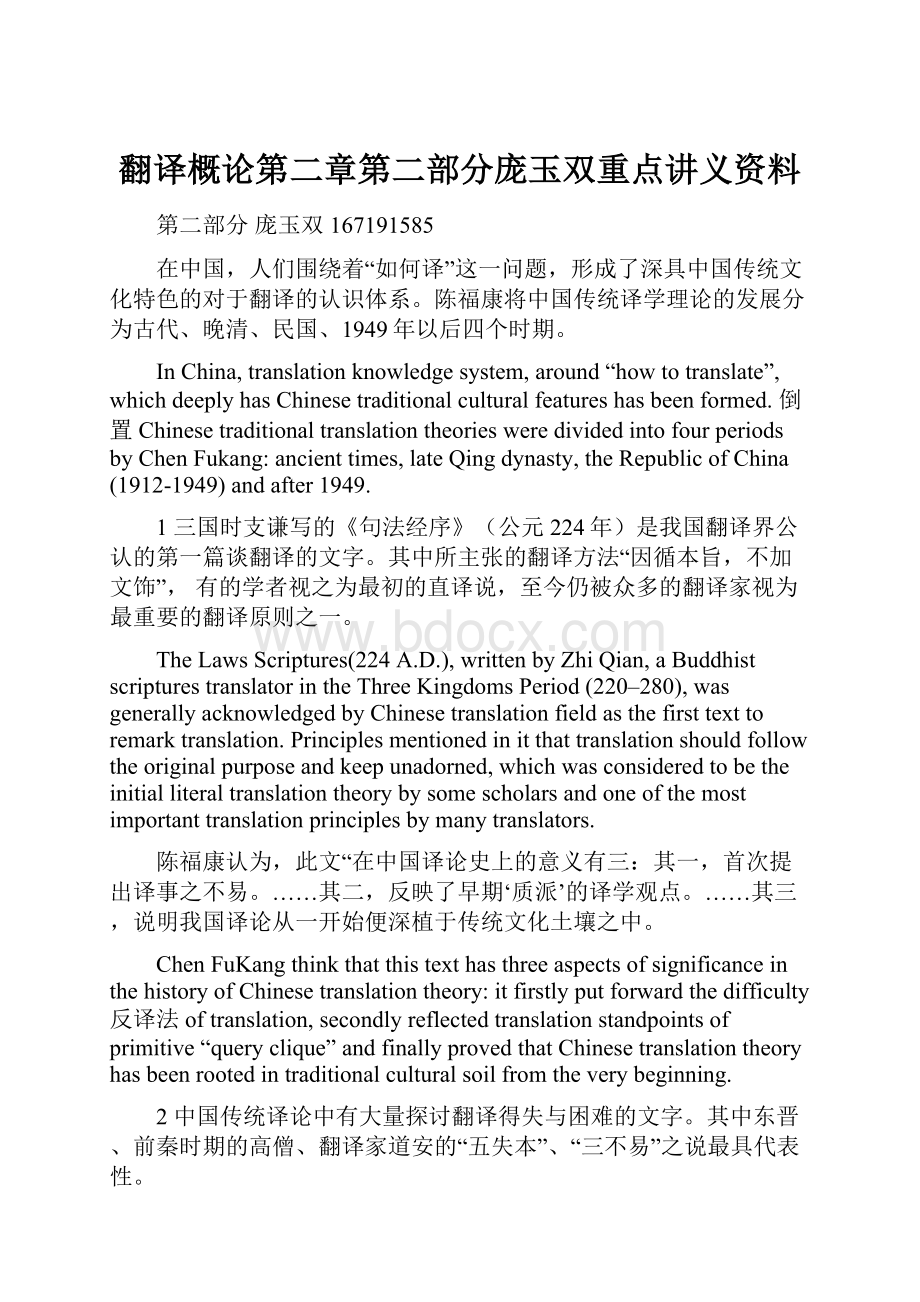翻译概论第二章第二部分庞玉双重点讲义资料.docx
《翻译概论第二章第二部分庞玉双重点讲义资料.docx》由会员分享,可在线阅读,更多相关《翻译概论第二章第二部分庞玉双重点讲义资料.docx(12页珍藏版)》请在冰豆网上搜索。

翻译概论第二章第二部分庞玉双重点讲义资料
第二部分庞玉双167191585
在中国,人们围绕着“如何译”这一问题,形成了深具中国传统文化特色的对于翻译的认识体系。
陈福康将中国传统译学理论的发展分为古代、晚清、民国、1949年以后四个时期。
InChina,translationknowledgesystem,around“howtotranslate”,whichdeeplyhasChinesetraditionalculturalfeatureshasbeenformed.倒置ChinesetraditionaltranslationtheoriesweredividedintofourperiodsbyChenFukang:
ancienttimes,lateQingdynasty,theRepublicofChina(1912-1949)andafter1949.
1三国时支谦写的《句法经序》(公元224年)是我国翻译界公认的第一篇谈翻译的文字。
其中所主张的翻译方法“因循本旨,不加文饰”,有的学者视之为最初的直译说,至今仍被众多的翻译家视为最重要的翻译原则之一。
TheLawsScriptures(224A.D.),writtenbyZhiQian,aBuddhistscripturestranslatorintheThreeKingdomsPeriod(220–280),wasgenerallyacknowledgedbyChinesetranslationfieldasthefirsttexttoremarktranslation.Principlesmentionedinitthattranslationshouldfollowtheoriginalpurposeandkeepunadorned,whichwasconsideredtobetheinitialliteraltranslationtheorybysomescholarsandoneofthemostimportanttranslationprinciplesbymanytranslators.
陈福康认为,此文“在中国译论史上的意义有三:
其一,首次提出译事之不易。
……其二,反映了早期‘质派’的译学观点。
……其三,说明我国译论从一开始便深植于传统文化土壤之中。
ChenFuKangthinkthatthistexthasthreeaspectsofsignificanceinthehistoryofChinesetranslationtheory:
itfirstlyputforwardthedifficulty反译法oftranslation,secondlyreflectedtranslationstandpointsofprimitive“queryclique”andfinallyprovedthatChinesetranslationtheoryhasbeenrootedintraditionalculturalsoilfromtheverybeginning.
2中国传统译论中有大量探讨翻译得失与困难的文字。
其中东晋、前秦时期的高僧、翻译家道安的“五失本”、“三不易”之说最具代表性。
TherearenumeroustextsdiscussinggainsandlossesanddifficultiesoftranslationinChinesetraditionaltranslationtheories.Ofwhich,“FiveDiscrepanciesandThreeDifficulties”ofT'ao-an,插入法eminentmonkandtranslatorintheeasternJinandtheearlyQindynasty,isthemostrepresentative.
他在《摩诃钵罗若波罗蜜经钞序》中指出:
Hedescribeddetailsinhisworks:
(对课本中文言文部分的解释)
所谓“五失本”,第一、胡文的词序是颠倒的,译时必须改从秦语语法;第二、秦人喜欢华美,要使读者满意,译文必须作一定的修饰;第三、胡经中同一意义,往往反复再三,译时不得不加以删削;第四、胡经于结尾处,要作一小结,将前文复述一遍,或一千字.或五百字,译时也得删除;第五、胡经中话已告一段落,将要另谈别事时,又把前话简述一遍,然后再开始,译时则又必须删除。
所谓“三不易”,就是说,圣人是按当时的习俗来说话的,古今时俗不同,要使古俗适应今时;把古圣先贤的微言大义传达给后世的浅识者,很不容易;当时编写经书的都是大智慧的人,现在让平常人传译,很不易。
译胡为秦,困难重重,稍有不慎,即可能使佛经失去本来面目。
从翻译实践中认识翻译之障碍,指出有可能“失本”的五种倾向,道安的“五失本”、“三不易’’之说对翻译者如何避免背叛原文,具有警示作用。
Buddhisttextsmaypossiblyloseitsoriginalsensebecauseofonerousdifficultiesandpotentialcarelessnessduringthetranslationprocessfrom“Hu”languageto“Qin”language.增译T'ao-an’stheoryrealizedobstaclesoftranslationfrompracticeandpointedoutfivetendenciesmayleadtoloseoriginalsense.Asaresult,his“FiveDiscrepanciesandThreeDifficulties”principlehaswarnedtranslatorsintermsofhowtoavoiddeviatingfromsourcetext.倒置
3如张思洁在《中国传统译论范畴及体系》一书中所言,自《法句经序》起,中国传统翻译思想大略经历了形成、转折、发展和鼎盛四个阶段,这些翻译思想具有共同的历史和文化渊源:
它们植根于中国的悠久文化,以中国古典文论、古代哲学及古典美学为其理论基础和基本方法;它们既相互独立又彼此联系,构成一条贯穿中国传统翻译思想的长轴。
Forinstance,ZhangSijiesaidinChineseTraditionalTranslationTheoryCategoryandSystemthatsinceTheLawsScriptures,Chinesetraditionaltranslationthoughtshaveroughlyexperiencedfourstages:
formation,transition,developmentandprosperity.ThesethoughtshavecommonhistoricalandculturalsourcethattheywereallrootedinChineselonghistory,whosetheoreticalbaseandfundamentalmethodsChinesefellonclassicalliteraltheory,ancientphilosophyandclassicalaesthetics倒置.AndtheyweredependentfromeachotheraswellasconnectedwitheachotherthustocomposealongaxisconnectingChinesetraditionaltranslationthoughts.
4罗新璋则从这条长轴中理出四个概念,高度概括了传统译论的历程:
案本-求信-神似-化境,这四个概念为我们探寻浩瀚的中国传统翻译思想提供了重要线索,是构筑我国传统译论的基础
LuoXinzhanghadsummarizedfourconceptionsthatcanhighlygeneralizethedevelopmentprocessoftraditionaltranslationtheoryfromthisaxis:
fidelitytotheoriginal,faithfulnesstothesourcetext,similarityinspiritandsublimationinmind,whichasthebasisofChinesetraditionaltranslationtheory,providedimportantcluestoexploreChinesetraditionaltranslationthoughtsforus.
不论是以支谦、支谶为代表的“文质说”,还是严复的“信达雅”,又或是傅雷的“神似说”,钱钟书的“化境说”,都体现出与现当代翻译理论截然不同的认知角度和认知观念。
对此,王宏印有十分精辟而恰当的归纳。
他认为,中国传统译论有如下五个特点:
“一、以道德为本位,强调译者道德修养和敬业从业为本的主体性意识。
……二、服务公众和社会的群体本位思想。
……三、人文主义的语言观而不是科学主义的语言观,始终是中国传统翻译实践的潜在的理论导向。
……四、人文社科类作为主要文本翻译的类型,在材料内容、语言类型和运思方式上都倾向于文学翻译的艺术性,而不是科学翻译的科学性。
……五、哲学的而非科学的、美学的而非宗教的,是中国传统译论的始终如一的理论基础。
”
Either“Meanings-BasedTheory”standbyZhiQianandZhiChen,YanFu’s“Faithfulness,ExpressivenessandEleganceTheory”orFuLei’s“SimilarityinSpiritTheory”andCh’ien Chung-shu’s“SublimationTheory”,hadembodieddistinctcognitiveangleandconceptionfrommodernandcontemporarytranslationtheories.Asforthesetheories,WangHongyinhadatrulyincisivebutappropriatesummarythatChinesetraditionaltranslationtheoryhasfivefeaturesasfollowing:
Firstlyitwasonthebasisofmoralityandemphasizedself-cultivationandprofessionalworking-basedsubjectivityawareness;Secondly,itincludedthestandard增译thoughtsofservingpublicandsocialgroups;Thirdly,notscientismbuthumanismlanguageviews,hasalwaysplayingapotentialtheoreticalleadingroleoftraditionaltranslationpractice;Fourthly,humanandsocialscienceworks,asthemaintypeoftexttranslation,intermsofmaterialcontent,languagetypeandthinkingmode,showedtendencytoartistryofliteraturetranslationnotscientificalnessofscientifictranslation;Finally,philosophynotscience,aestheticsnotreligionarealwaysthetheoreticalfoundationofChinesetraditionaltranslationtheory.
5纵观中西传统译论,我们发现,在很长一段历史时期里,人们对于翻译活动的认识主要停留在经验和文本层面,更多的是从翻译的得失与困难以及对翻译方法与技巧的探索这两个方面来认识翻译。
Throughouteasternandwesterntraditionaltranslationtheory,wecanfindthatduringalongtimeinhistoryperiod,ourknowledgetotranslationactivityhasbeenmainlystayingonexperienceandtextlevelandpayingmoreattentiontotwopartsoftranslation:
difficulty,gainandlossoftranslationaswellasexploitationtotranslationmethodsandskills.
如何译?
译得如何?
这些可以说是从古代到近代的各国翻译家苦苦思索的一个永恒主题。
经过漫长的历史积累,有关这方面的思考已经相当系统,为翻译家们的实践提供了重要指导,也为现代翻译理论的构建提供了宝贵资源,并给现代翻译理论家们以重要启示。
Howtotranslate?
Whataboutthequality增译oftranslation?
Thesequestionsareregardedasaneternalthemethattranslatorsinallagesandfromallcountrieshavebeenpuzzlingabout.Afteralongtimeofhistoricalaccumulation,rathersystematicthinkinginthisaspecthasprovidedimportantguidancefortranslators’practiceandvaluableresourceforconstructionofmoderntranslationtheoryaswellasinspiredmoderntranslationtheorists.合译
6但同时我们也发现,由于长期以来人们在翻译活动的过程中缺乏理论意识和学科意识,造成翻译活动的许多维度得不到揭示,对翻译活动的认知被一种简单化和非本质化趋向所限制。
However,inthemeantimewefindthatsincewehavebeenlackingtheoreticalandsubjectiveconsciousnessforalongtime,manydimensionsoftranslationactivitystillhadn’tuncoveredandcognitiontotranslationactivityhadrestrictedbysimplificationandnon-essentialismtendencies.
要真正全面地认识翻译、理解翻译,就离不开现代学理对翻译活动的观照。
而在我们对翻译进行科学解剖之前,有必要先认识一下翻译活动的丰富性与复杂性。
Reflectiontotranslationactivityinmoderntheoryisnecessarytotrulyandcomprehensivelyknowandunderstandtranslation.Andbeforewescientificallydissecttranslation,转译itisurgenttobefamiliarwiththeabundanceandcomplexityoftranslationactivity.
2.2Theabundanceoftranslationactivity
7翻译是一项具有丰富内涵的复杂实践活动。
美国著名语言学家雅各布森曾将翻译分为语内翻译、语际翻译和符际翻译
Translationisacomplicatedpracticeactivitywhichhasrichconnotation.RomanJacobson,famousAmericanlinguist,dividedtranslationintothreecategories:
intralingualtranslation,interlingualtranslationandintersemiotictranslation.
由此提出了广义的翻译概念,大大拓展了翻译的内涵。
英国翻译理论家乔治·斯坦纳(GeorgeSteiner)提出理即翻译,在某种意义上将翻译哲学化,为翻译成为许多学科研究的基本结构(如人类学)奠定了重要基础。
我们通常所讲的狭义的翻译概念,指的是语际翻译。
如果细究翻译类型、翻译过程和翻译结果,我们也会发现,即使是狭义的
翻译,也具有各种各样的形式,而这些形式的产生和演变,是历史、文化、文学、译者主体性等不同因素综合作用的结果。
对于翻译活动复杂性的考察,有助于我们全面认识翻译,从而对传统翻译观提出质疑。
Thusthegeneralizedtranslationconceptwhichgreatlyexpandtheconnotationoftranslationwasputforward.GeorgeSteiner,Britaintranslationtheorist,consideredunderstandingastranslation.Inhisopinion,philosophizingtranslationinasenselaidasolidfoundationforthattranslationcanbebasicstructureofmanysubjectstudies(suchasanthropology).Generallyspeaking,translationconceptinnarrowsensereferstointerlingualtranslation.Ifwecarefullystudythetype,processandresultoftranslation,wecanalsofindthatevennarrowtranslationhasvariousformswhoseemergenceandevolvementwereresultedfromsyntheticactionofhistory,culture,literature,translator’ssubjectivityandotherdifferentfactors.Researchestocomplexityoftranslationactivitycanhelpustocomprehensivelyknowtranslationthustoquestiontotraditionaltranslationpoints.
比如,按照我们通常的理解,翻译一定是一种跨语际实践。
那么,“跨语际”究竟能不能作为界定翻译与非翻译活动的标准?
换句话说,一种语言活动在什么样意义上去跨语际,就能被称作为翻译?
我们不妨以林纾为例来说明问题。
林纾是清末享有盛名的翻译家,他在近三十年的时间内,翻译了一百八十几种小说,对中国社会产生了巨大影响,被胡适称为“介绍西洋近世文学的第一人”
Forexample,accordingtoourgeneralunderstanding,translationisacross-languagepractice.Sowhether“cross-language”canbethestandardtodefinetranslationandnon-translationactivity?
Inotherwords,inwhatsensetocrosslanguage,alanguageactivitycanbecalledtranslation?
WecanmakeanexamplewithLinShu,awell-knowntranslatorinlateQingdynasty.Hetranslatednovelsover180within30years,whichhassignificantinfluenceonChinesesociety.Hewascalled“theFirsttoIntroduceWesternPre-modernLiterature”.
8可是林纾自己不懂外文,他所译的所有外国文学作品都是和懂外文的中国口述者合作完成的,故有“耳受手追,声已笔止”之说。
LinShu,ascholaroflittleknowledge反译offoreignlanguages,withallhistranslationsaboutforeignliteraturedoneincooperationwithotherChineseelitesofhistimeproficientinforeignlanguages,isatranslatorinawayofjustwritingdownwhattheyinterprettohimand拆译,重组,转译
A:
oncetheinterpretationisover,histranslationisdone.Sotherefollowsthesayingas“earsin,handout;voice